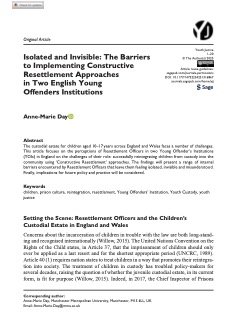By the National Autistic Society (UK)
Autistic people, like anyone else, can sometimes come into contact with the criminal justice system. Our new report illustrates how a lack of support for young autistic people, both before entering and within the system, can have profoundly negative consequences on future life chances. The experiences of people in our report illustrate clearly what changes need to happen, reaffirming recommendations we have been calling and campaigning for.
Preventative support is needed for autistic young people at risk
The average age range for early concerns for both autistic adults and parent/carers is 13-15 years
Many autistic respondents had not had their autism diagnosis until adulthood, whereas most relatives of parent/carers were diagnosed at primary school age
75% of autistic adults and 86% of parent/carers reported that they had been visited at least once by the police
The top early concerns for parent/carers and professionals were being easily led or influenced by peers, violence or aggression toward others, damage to property or fire setting and being excluded from school.
Failings in understanding and support from schools, statutory services, healthcare and the criminal justice system have also been defining factors, as illustrated from the following case study:
“For 18 months, I had been suffering from severe suicidal ideation...The GP still did nothing… so I tried other ways of getting help and therapy, but that had led to nowhere because waiting lists were so phenomenally long, so I committed the index offence in the context of trying to draw attention to my plight and need.”
More support is needed for autistic young people in the criminal justice system
71% of criminal justice professionals believe processes for identifying autistic offenders are ineffective or only effective in a minority of cases
64% of professionals (from a variety of sectors) only occasionally or rarely get the support they need to support autistic people
Up to 54% of relatives of parent/carers disclose their autism diagnosis, whereas up to 47% of autistic adults did not have an autism diagnosis to disclose when first involved with the justice system
In most cases both autistic adults and parent/carers received no reasonable adjustments from all sections of the criminal justice system. When they were put in place, adjustments that were common when being interviewed by police were use of an appropriate adult and clear language when questioning. In court the most common adjustments were assessment by a psychologist or psychiatrist and being told in advance what to expect. For professionals in our sample, the main barriers to implementing reasonable adjustments were lack of awareness and understanding of autism and effective identification processes. To address this both the survey and interviews have highlighted the need to develop consistent infrastructure for identifying, diagnostic referral routes and more efficient sharing of information between internal and external agencies.
Some of our top recommendations
Our research findings reaffirm recommendations made by our charity in the past, as well as the All Party Parliamentary Group on Autism (APPGA) and the HM Inspectorates of Prisons and Probation services report in regards to awareness and support, which can be summarised as:
Mandatory autism training across all sections of the criminal justice system and other sectors such as schools and health & social care services
Improved access to post diagnostic support and low-level support which can tackle early concerns of young autistic people
Accreditation, quality assurance and monitoring of autism best practice across services
Improved access to specialist resources and key services for professionals when supporting, screening or referring for diagnosis.
Improved awareness on what reasonable adjustments can be used and how to implement them within all criminal justice sectors
Access to best practice teams and autism champions
Clare Hughes, Criminal Justice Manager at the National Autistic Society, said: “No autistic child or young person should be at greater risk of being in the criminal justice system just because they are autistic. But our research shows the impact can be devastating when it happens.
“There needs to be better understanding of autism and support for autistic young people in every part of the system. The right early support must also be available to stop autistic young people from entering the system in the first place, including mental health support to navigate what can feel like a chaotic and overwhelming world.
“Staff working in the criminal justice system must be supported to understand what autism is and how to meet autistic young people’s needs. Autistic young people have already been failed by entering the system in the first place, there is no excuse to fail them further.
“We’ve been calling for many of these recommendations for years. Government must act now, once and for all, to ensure that autistic young people in the justice system are not forgotten.”
Laurie Hunte, Criminal Justice Programme Manager at Barrow Cadbury Trust/T2A (Transition to Adulthood), said:
“I welcome this new report from National Autistic Society focusing on autistic young people and the criminal justice system. It reveals how autistic young people need a distinct approach both to recognise the difficulties of their transition into adulthood, but also to support their needs as autistic young people in the Criminal Justice System.
The report highlights how a failure to diagnose autism early on means a young person is more likely to get involved with the criminal justice system, a system which is not geared up to support young autistic people.”
London: National Autistic Society, 2022. 41p.





















